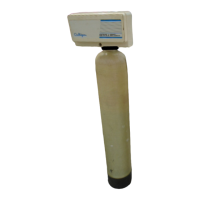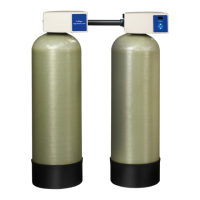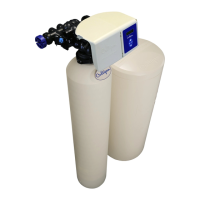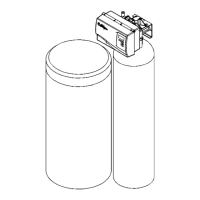Initial Startup 11
Cat. No. 01023094
Initial Startup
1. Open the feed water supply valve.
2. Direct the product water tubing to drain.
3. Open the recirculation valve (HCV-1) fully counterclockwise, then close two turns.
4. Connect the system to the power supply. You must press the Run Now button for the unit to start up without
delay.
NOTE If the inlet pressure falls below 20 psi during operation, a booster pump will be necessary.
CAUTION! If the pump chatters loudly, it is starving for water (cavitating). Turn the unit OFF
immediately to prevent pump damage. Correct the low pressure condition before
proceeding.
5. Check for leaks at all tube fittings and threaded joints.
6. Set the inlet pressure regulator (installed ahead of the Pre-filter) to 10 psig (69 kPa) below the minimum reading
shown on the inlet pressure gauge, but no lower than 20 psig. This will allow for pressure variation in the feed
water.
7. Slowly close the recirculation valve until the desired product flow rate is attained. Check again for leaks.
8. Allow the unit to run so that the shipping solution (sodium bisulfite and glycerin) is flushed from the system. Test
the concentrate water for sulfite; continue flushing until no sulfite is detected.
CAUTION! As the concentrate flow is reduced, the system pressure will increase. Open the sys-
tem pressure control valve as required to prevent the system pressure from exceeding
150 psi (1034 kPa). Excessive pressure will damage the pump and may cause property
damage. Excessive pressure may also damage the membranes, fittings, and tubing,
which may also cause property damage.
NOTICE Depending on the feed water quality, it may be possible to operate the unit with a lower concen-
trate flow rate, which would decrease operating costs. Refer to the printout from the Culligan®
CAAP® (Computer Aided Application Program) software, which indicates maximum allowable
recovery. If a printout is not available, contact the Culligan dealer.
9. Measure the product flow. Adjust the feed pressure with the system pressure control valve until the product
flow is approximately 10% higher than the flow required for the application.
NOTICE By adjusting the feed pressure as low as possible to meet the application requirement, the service
life of the pump and RO elements will be optimized. The system should run continuously, rather
than go through frequent start/stop cycles. Do not exceed specified product flow rate!
